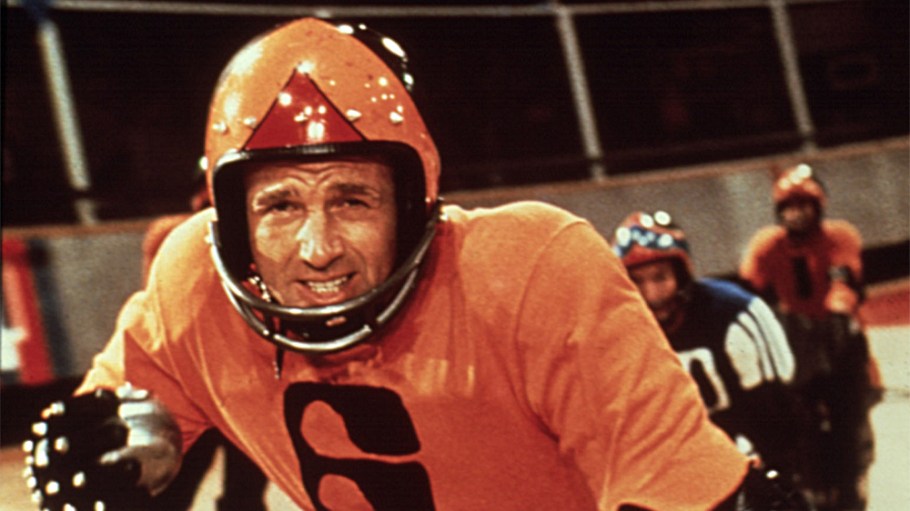By Ray Bennett
LONDON – ‘Rollerball’, Canadian filmmaker Norman Jewison’s only film set in the future, also is his most action-packed and violent and it was inspired by an experience at a National Hockey League (NHL) game.
Released in 1975, it’s set 40 years in the future with James Caan (pictured above) as a star player in a team sport called rollerball that is designed to distract the public from corporate dictators. A race involving skaters, motorcycles and a flying metal ball on a circular indoor track, it degenerates into one filled with aggression, violence and many deaths.
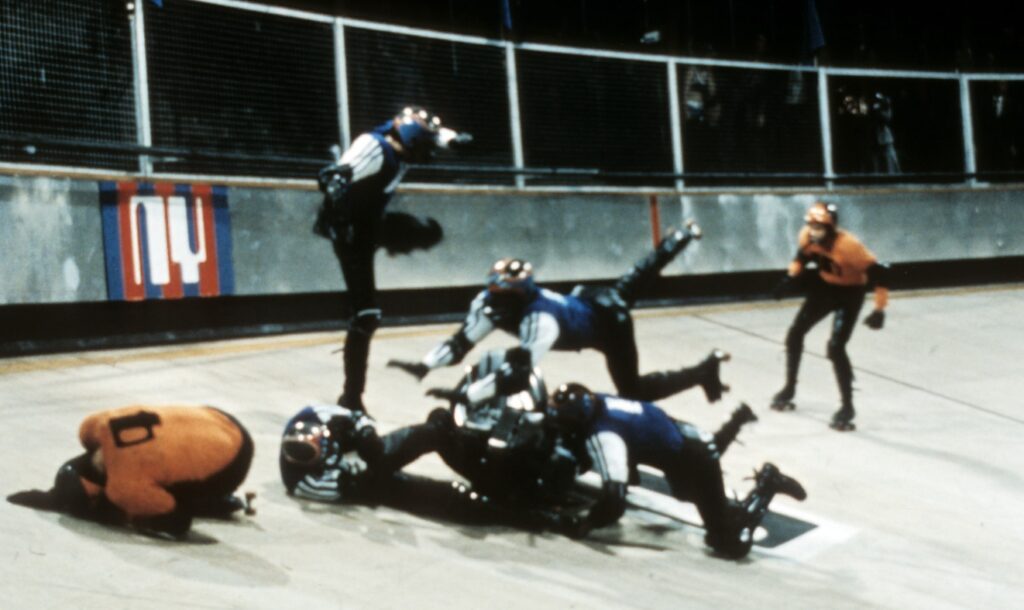 It was a substantial hit with a domestic North American box office of around $30 million from a budget of less than $6 million. It ranked twelfth in popularity, ahead of movies such as ‘Barry Lyndon, ‘The Eiger Sanction’ and ‘French Connection II’, in a year when only two films made more than $100 million – ‘Jaws’ with $260 million and ‘One Flew Over the Cuckoo’s Nest’ with $109 million.
It was a substantial hit with a domestic North American box office of around $30 million from a budget of less than $6 million. It ranked twelfth in popularity, ahead of movies such as ‘Barry Lyndon, ‘The Eiger Sanction’ and ‘French Connection II’, in a year when only two films made more than $100 million – ‘Jaws’ with $260 million and ‘One Flew Over the Cuckoo’s Nest’ with $109 million.
Still, Jewison was conflicted over its success, especially in the United States where he felt it was misunderstood. ‘One of the reasons I made the film was because of my horror of violence in sport, that people were actually being injured permanently,’ he told me when we spoke during the Ghent International Film Festival in 2011.
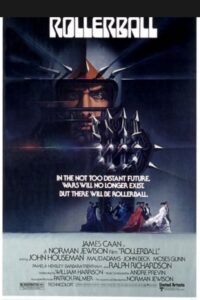 Solidly Canadian, he blamed that country’s southern neighbour for the way ice hockey had changed noting that the NHL used to be six teams, New York, Montreal, Boston, Toronto, Winnipeg and Detroit. ‘The moment the Americans moved in on Canadian hockey, they took the rights to the NHL and moved from Toronto down to New York,’ he said. ‘Well, all of a sudden you’ve got Atlanta and Dallas, all these teams. They don’t even have ice there! It doesn’t even get cold, for chrissake. Then hockey started to change. It started to become more violent. It started to be about hitting. It started to be about punishing people. It started to be about bullying. All of a sudden there were enforcers.’
Solidly Canadian, he blamed that country’s southern neighbour for the way ice hockey had changed noting that the NHL used to be six teams, New York, Montreal, Boston, Toronto, Winnipeg and Detroit. ‘The moment the Americans moved in on Canadian hockey, they took the rights to the NHL and moved from Toronto down to New York,’ he said. ‘Well, all of a sudden you’ve got Atlanta and Dallas, all these teams. They don’t even have ice there! It doesn’t even get cold, for chrissake. Then hockey started to change. It started to become more violent. It started to be about hitting. It started to be about punishing people. It started to be about bullying. All of a sudden there were enforcers.’
He recalled one Saturday night when he went to game in Chicago in a crowd of 16,000 people: ‘The stadium is so steep. Bam! One guy hits another one and there’s blood on the ice. When that red blood hit the white ice everybody was like they were being fed and they started to scream. It got scary. I saw all the police and all the ushers move to the bottom of the aisles, it all happened magically and I realised that that was what it was all about: they were selling violence. I thought, Jesus, has the player been blinded? He had a stick in his eye, there’s blood all over. They come out with a stretcher and they take the guy off the ice and push the blood to the side. All right, let’s continue the game. Holy shit! I got so upset that it was part of my motivation to make “Rollerball”. I wanted people to be frightened by the whole idea of “Rollerball”, that it’s like going back to Circus Maximus, it’s inhuman.’
He also had been inspired by meeting American director Stanley Kubrick after he left the States to spend most of the Seventies in Europe. ‘He was living in London and making films there when I was there so I got to him. He was totally paranoid about the state of the world and I caught some of that.’
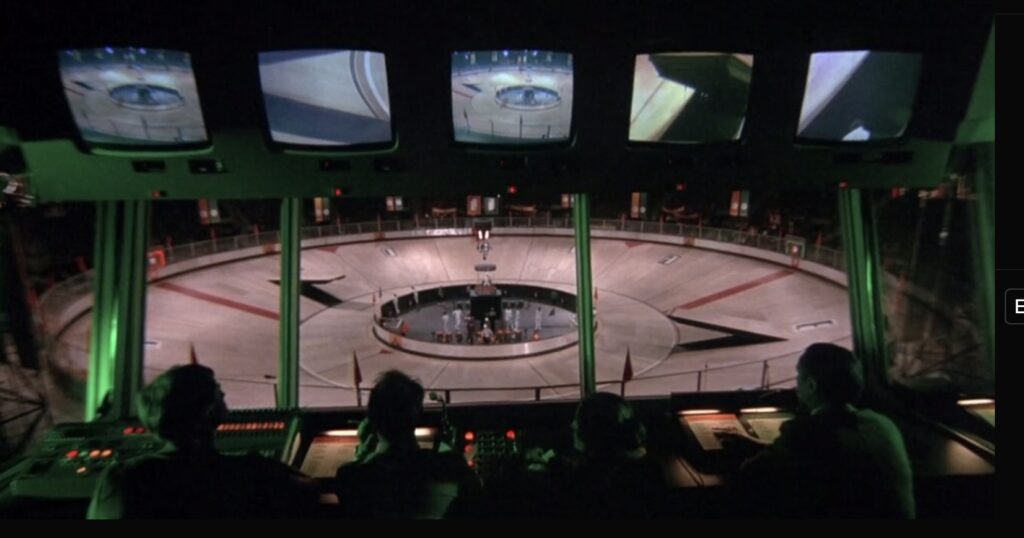 He bought the script for ‘Rollerball’ from William Harrison who had adapted it from his own short story titled ‘Roller Ball Murder’ that appeared in Esquire Magazine. He knew there would be logistical difficulties from the outset.
He bought the script for ‘Rollerball’ from William Harrison who had adapted it from his own short story titled ‘Roller Ball Murder’ that appeared in Esquire Magazine. He knew there would be logistical difficulties from the outset.
‘We shot the film in Munich as it was the only place that had a circular stadium that could handle motorbikes and skaters because it was a wooden track,’ he said. ‘It was built for the Olympics and it was perfect. Without it, I couldn’t have made “Rollerball”. I took [production designer] John Box to Munich and then back in England we sat down for days trying to work out this game. I mean, how do you invent a game? It’s the hardest thing in the world. It’s got to have rules, it’s got to have penalties … it’s ridiculous. We’re literally sitting there trying to figure out how do you play rollerball? Nobody knew; it had never been played.’
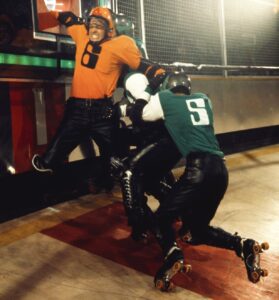 ‘Wasn’t it in the script?’ I asked. ‘Hadn’t the scriptwriter worked out the game?’
‘Wasn’t it in the script?’ I asked. ‘Hadn’t the scriptwriter worked out the game?’
Jewison shook his head: ‘No. He didn’t know how to play it. He described it as people on skates and a ball being shot out of a cannon. He took the idea from a board game … I mean, you can’t do that with people and this ball whizzing around.’
He and Box built a replica of the Munich stadium about the size of a bar table and tried to figure it out. ‘We were sitting in Pinewood Studios with this fucking thing,’ he said, ‘shooting this ball around. I said it was like a roulette wheel so it’s got to start falling the moment it starts to lose speed. Yes. So that’s when we can scoop the ball up. That’s right. And if you had a big glove. Yes, let’s get a fucking glove. We literally – and the writer was of no help at all, he was, “Well, I don’t know, they’re on motorbikes and you grab the back of the bike” and I’m “Are you kidding? How can we do that, for chrissakes, without killing somebody?” So then we had to get stuntmen to rehearse and train. I had Jimmy Caan, actors, grabbing ahold of the back of bikes and we had to teach them how to skate. God, it was a nightmare, a fucking nightmare.’
They finished the picture and then came another surprise. ‘You know something?’ Jewison said, ‘“Rollerball” became a cult film in England. It was the British who embraced it and then the Europeans embraced it. It went to America and the Americans didn’t get it. The Europeans got it. The Americans loved it, loved the violence. I think the film was reviewed by Red Smith, who was the sports writer for the New York Times, instead of the film critic and that appalled me. It opened and everybody wanted to buy the fucking game. They didn’t care. Kill a few people, what does it matter? I mean, the Americans were all for it. That just appalled me. I said, I don’t want to be associated with this. No, you can’t buy the game. I said, this is bizarre; this is Circus Maximus. You just want to sell tickets to see somebody creamed. Oh, God. Only in America.’

